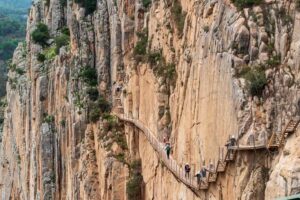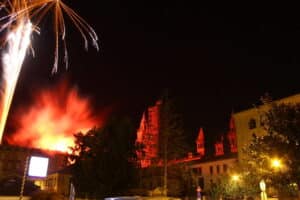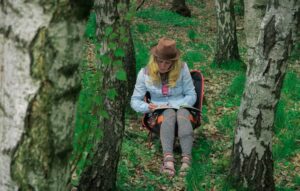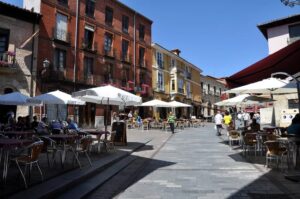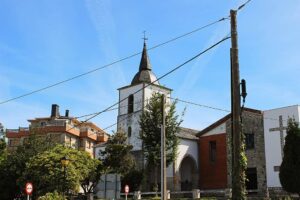His full name is Pedrafita do Cebreiro. It is a town in the province of Lugo and which in turn depends on the Os Ancares region. It has an area of 105 km and a population that It barely exceeds a thousand inhabitants, so it is charming, quiet and above all with great natural beauty.
It is located 1.098 meters above sea level, which makes it the municipality highest in the entire province of Lugo and Galicia in general. It is especially popular in winter, when its landscapes are filled with snow and Galicians come in search of their delicious traditional seasonal food.
Furthermore, it is an obligatory step for all those pilgrims who opt for the French Way to Santiago.
Índice de contenidos
Everything you can see in O Cebreiro
During Roman times, this port was crossed by the road that leads from Braga to Astorga, known as the via nova. Over time, it would become a medieval road that reached the city of Santiago de Compostela.
Or Cebreiro It is the first town on the French Way in Galicia, entering through the province of Lugo, just over 40 km before reaching Sarria. In fact, many of the pilgrims who make the road from Sarria to Santiago de Compostela They end up joining those who come from O Cebreiro.
Whether you are a pilgrim or just passing through, these are its main points of interest.
The pallozas of O Cebreiro
Here they are extremely famous pallozas, Which are a kind of Typical high mountain homes. They have a circular floor plan and vegetal roofs. They were declared an Asset of Cultural Interest, since according to historical data, They date from pre-Roman times and went used well into the 20th century.

His name is a kind of alteration of the term pallaza, a word of Galician origin that refers to the material with which the roof of those houses was made. For some, they bear a strong resemblance to traditional Iron Age cottages in Britain.
Ethnographic Museum of O Cebreiro
We could say that it is rather a kind of exhibition of the pallozas of O Cebreiro. In this museum you can see three of the four, since the last one is used as a warehouse. Here you will see a little of the lifestyle typical of the high mountains, with furniture, farming tools, sewing tools and many other antique objects that are preserved there.
The pallozas exhibited are distributed in different categories:
- Quico Palloza: Shows a little of what the ancient economy of O Cebreiro was like
- Palloza by Xan López: The most traditional, with domestic life and the daily life of families.
- Palloza de Galan: It shows the process of adaptation to the environment of the inhabitants.
- Palloza de Campelo: It is the one that we tell you is used as a warehouse and room for various uses.
Church of Santa María a Real de O Cebreiro
This, without a doubt, is the most important religious building in the area. It is a church built mid 9th century. They also had the function of accommodate all pilgrims of the Camino de Santiago that arrived at the town.
In 1072, it became directly dependent on the Order of Cluny, which led it to become one of the most important temples in the entire province.

The construction is a clear example of the Galician early medieval architecture. It has an irregular floor plan and a low tower and inside, three naves, with the central one taller and wider compared to the rest. It is a typical medieval church like many of those that pilgrims find in their Camino de Santiago trips. A must-see site for anyone who passes through this town.
O Cebreiro and the Holy Grail
According to legend, the Holy Grail is the chalice used during the Last Supper by Jesus Christ. He was transferred to Britannia, where a dynasty with its guardians would be created for all eternity, however, he never reached his destination.
At the beginning of the 14th century, during a severe winter, a peasant from the village exposed himself to the harshness of the weather to hear mass. Once in the temple, the local priest scolded him for his audacity and for exposing his life in this way.
In the middle of mass, during the Consecration, the host turned into flesh and the wine into blood. Furthermore, the priest who had belittled the peasant died immediately. The church bells began to ring alone, which caught the attention of all the inhabitants of the town who came to contemplate the miracle.
The elderly say that the image of the Virgin Mary that was located on the main altar to the side, tilted its head and in this way observe the miracle. Image that is currently preserved in this position.
The story of the miracle spread quickly throughout Europe and thanks to this, the sanctuary received visits from great people. Some of them were the Catholic Monarchs on their pilgrimage to Santiago de Compostela in the year 1486. For that moment they donated the reliquaries and the chalice that are currently in the church of Santa María do Cebreiro.

Other Jacobean Routes
Every pilgrim who appreciates the Camino de Santiago cannot miss other pilgrimage routes to Compostela.
One of the most picturesque landscapes that offers the walker is the Northern Way, which goes from west to east along the coast of the Cantabrian Sea, and can be done in about 35 stages. It is one of the most demanding, and it is preferable to do it in summer, since in winter the climate is usually very hostile.
And speaking of coasts, on the Atlantic Ocean, the Portuguese Way of the Coast, leaving from Porto, passing through Viana do Castelo and Vigo, can be done in a couple of weeks. To reduce it by about 75 kilometers, some pilgrims prefer to start it in Viana do Castelo.
Finally, the Portuguese Way of Tui, which although it starts in Lisbon, many decide to do it from the neighboring city of Tui (Pontevedra), in about 8 days.


